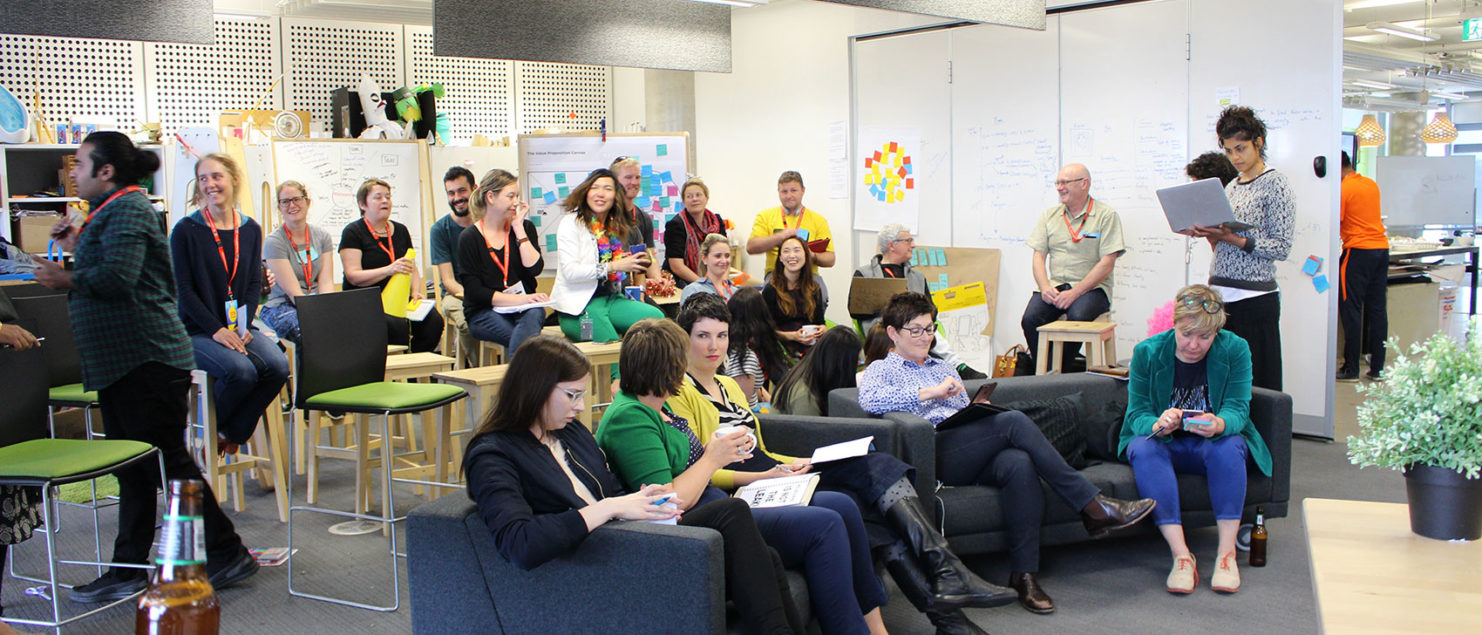Those who choose to serve in public services all around the world do it for a number of reasons. Security. Flexibility. Comfort with hierarchy and knowing one’s place. And, for most that I have met and had the honour and privilege of serving with, for the love of community. They get up in the morning and enter struggling, bureaucratic systems that are creaking at the seams with complexity. Systems terrified by uncertainty and the fluid risk that comes with an interconnected network society. In our late Western democracies, they face another problem … one that cannot be solved easily. In a world that is defined by the speed of information, they are tied to arcane and obsolete Parliamentary systems. Vertical and siloed hierarchies that are themselves being crushed by the immediacy, amplitude and variability of multiform threats. The capacity to act, as opposed to react, to emergent phenomena in our societies, is limited. This is a structural problem.
Time is the resource than no one has. In my business, The Still Dynamic, we frame ourselves not in terms of “lifetimes,” the long view over the past. Instead, we speak of “time-life.” Our lives are sacred. Our lives are precious. Between health and the absurdity of blameless random, there are only moments. How we choose these moments defines our sense of ourselves and our purpose in the world. These are the immediate, the instantaneous, the tangible moments of connection. Connection to objects, connection to phenomena, connection to other beings, connection the people we intersect with, and most often forgotten, our connection with ourselves. We bleed time-life when we cease to be intentional and are instead carried away by the flood and struggle of living. Victor Frankl wrote words that seed every present moment with poignancy, words that people, collectives of people and the societies that they form in peaceful cooperation, may do well to heed:
“Between stimulus and response there is a space. In that space is our power to choose our response. In our response lies our growth and our freedom.”
Much time is spent agonising over security when every stimulus in our world dictates that impermanence is the order of things. The response to uncertainty in government has been to fight it, deploy resources and “time-life” to the normalisation of patterns of behaviour and interaction, largely from old and no longer relevant information. This is no longer a viable strategy. What got us here, will not get us there, to parse Marshall Goldsmith.
There is another way. It is to embrace uncertainty, to become her lover, to become intimate with her and feel her curves, her agitation and the deep patterns that unfold at her surface as surprise and horror. Luckily for us as a species, we have two hemispheres in our brains and a highly evolved frontal cortex, all intricately connected through our corpus callosum — the internet of our brains. The emotive, associative power of our right hemisphere when active supports the “intuitive” sense of pattern making — knowing the big picture — and via its interaction with the left brain support us to make sense of the world in speech, letters and numbers — creating linear activities in time that may effect the outcome. We are evolved for uncertainty. We may have lost some of this confidence in our sedentary societies, but it is there, the intelligence is in our bodies.
Humans are meaning makers. As a species we have already established ways of creating patterns of meaning from the seemingly incoherent and meaningless. This is the discipline of design. In the creation of objects in the world, we have traditional design. In the interaction between objects and other man-made phenomena in the world we have design thinking. In the humanisation of experience, the optimisation of information and the seamless navigation of interactions that deliver value, we have service design. Evolving from the need to know better, to learn from one another to be inclusive, to share risk and increase the chances of adaptive success, we have co-design. The last three sit in an ever-emerging space known broadly as human-centred design, and it is burgeoning around the world. Its success is the privileged place it gives to emotion and most importantly, empathy.
Jamming is to service design, what hacking is to technologists.
However, in the seemingly endless chaos and disorder that assaults our senses, as a species we revert to our oldest and most primitive instinctive brain, the amygdala. We have limited choices — fight, flight and freeze. All around us today we see these phenomena in the poorly considered decisions that in aggregate threaten us all — the retreat from universal human rights, the rise of neo-fascism that a generation paid in horror, terror, blood and death to prevent in the 20th century, accelerating climate change, financialization and ephemeralisation of the “real and tangible” economy — remember, the one that we live, eat and breathe in. So what does all of this have to do with GovJam and jamming? It has everything to do with GovJam and “jamming.”
Jamming is to service design, what hacking is to technologists. Taking its metaphor from music, people arrive with their instruments and begin to “play.” The listen, they respond. They work towards immersion and effortlessness, allowing the music to speak. No one instrument dominates. And, together they get their groove on and make magic.
The motto of the Global Jams is “doing, not talking.” Jammers don’t talk about their ideas and make presentations. They make their ideas, test them with their users, they break them and remake them until there is something new and novel that creates value for their users. Value that is human, value that lives and breathes with empathy as it’s beating heart. So how does this work?
At a Jam, we begin with a secret theme. It usually causes incredible confusion and puts the everyday mind out of balance. From this we work together as teams or as a room to generate as many impression, thoughts, feelings, pictures and ideas from this thematic prompt. These are organised into themes, and from the themes problem spaces evolve. From the problem spaces, a question. A very special type of question, what I like to call a “goldilocks” question (for the record, I believe Goldilocks was a trespasser and a thief who took advantage of the bears, however in fairness the bears may have some occupier’s liability issues as well). A Goldilocks question is one that is not too big to solve “how might we create world peace?” and not too small “how might we create a poly-carbonate 3D printer?” (does this exist — I’ll have to ask the Internet after this article). It is more like “how might we support users of methamphetamine to live drug-free lives?” or “How might we transition communities like the La Trobe Valley after the exit of large employers to more local and resilient high value economies?” Not too big, not too small, just right — enough space for creativity, exploration and experimentation.
We then explore this question through research and seek to create insight. Critically, we locate the user of the service. Asking, who is this service for? And we seek to understand, not just their problem, but their lives — their context — and we do this by engaging our frontal cortex and generating a sense of who they are in the world that allows us to emote and feel empathy towards them, not as customers, as people. From here there is an array of service design tools and other meaning making tools that support the acceleration towards creating a prototype of a service for that user. This is tested, where possible, directly with the user. They, the user, as my peer and super-awesome Jammer Liisa Vurma at Studio Thick is fond of saying, are the experts of their own experience. Nothing you tell them or sell them will change that. The process repeats from the user-feedback and the prototype is iterated, winnowing itself closer and closer to what the user actually needs and will receive new and real value from.
Each team pitches to their peers and others during the event and makes a video that explains the service-in-motion to their prospective users and other stakeholders. What is made? A functional prototype that meets user need (it is not the final product or service, it is an early iteration of a proposed state). This prototype service is articulated into a system that has considered, and is actively designed for interdependencies, with an empathetic presence at each and every touchpoint and interaction that the team were able to consider in the time. Done completely, this all comes with a business model for sustainable operations into the future.
How long does this take? Approximately, 19.5 hours of intense humanity. And, anyone can do it with the right conditions. Jams work with play, improvisation and other techniques to support people to stay out of their amygdalae (yes, that is the plural … oh an ode to Latin) and up into their frontal cortex.
How is that possible? Oxytocin. The Still Dynamic (TSD) and its amazing volunteers build an environment of self-care, responsibility and fun to support you to be your best as individuals, as teams and as a cohort in the jams we host. It is similar at jams around the world. People really connect. Many lasting friendships are made.
TSD exists to support and scale symphonies of human beings — we reach for our highest expressions together. Unlike most work practices, we do this by facing and walking into the messy, emotional, layered internal worlds of each individual who will form part of the team. Bill O’Brien spoke a deep truth about the species and its capacity to manifest excellence in any endeavour, and he spoke it to the individual in stating:
“The success of an intervention depends on the interior condition of the intervenor.”
This is important for those who dream of something more, something different, and frankly, ignoring this is the issue with politics, governance and organisational health in legacy hierarchies today. This is where we start, and what results, when done with skill and care, is the future of work. Another of the touchstones that support our work and the intimacy we seek with ourselves, our clients and our world is that
the future is made by those who are “present.”
Global GovJam (#ggovjam) is on around the world in multiple sites and time zones from 16 May to 18 May 2017. Melbourne (#govjammelb) is honoured to be chosen as the Host City for this year’s Headquarters. The Global GovJam HQ is moving here from Europe and Timor Leste for the event.
Post-script: GovJam 17 Melbourne was a tremendous success. The participants and volunteers left energised, focused and more confident of their capacity to innovation with citizens. Special thanks to our fantastic feedback panelists who provide insight and support to the teams on their journey: Cat Hayes, Will Donovan, Claire Tomlinson, Ruth Mirams, Mark Bergin, Geoff Gourley, Sam Hannah-Rankin and Adam St.John Lawrence
Article first published on Medium, 6 May 2017


Share your thoughts